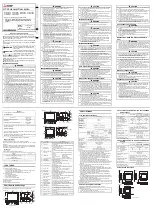
52
Installation
Fire detection and extinguishing system
4.1.1 Affixing cabinets to one another
The cabinets can be attached together by aligning the bottom of one cabinet with
the top of another.
This operation allows you to join together up to 4 cabinets.
1.
Remove all modules and wire/cables from the cabinets,
2.
Remove the seals from holes used for affixing cabinets together.
3.
Align the cabinets and, using the bolts (supplied with each cabinet), secure
them together.
4.
Connect the CAN DRIVE+ bars of each cabinet to each other with the CAN
cables and flat cables supplied with the cabinet (
paragraph 4.6.4 Multi-PRCAB+
cabinet wiring
).
5.
Install the necessary modules and proceed with the installation of the control
panel.
4.1.2 Mounting the kit
This accessory kit must be mounted to the 19" rack before the
Previdia Ultra control panel is installed.
1.
Attach one of the two support brackets to each bar on the
rack, using the available holes.
2.
Mount the cabinet to the bracket by inserting the threaded
rivets through the holes on the back of the enclosure, then
secure it in place using the supplied nuts.
4.2
Mounting the IFAMPSU power supply
The IFAMPSU power supply module must be mounted in the alloted space inside the PRCAB+ metal cabinet:
1.
Pair up the three tabs on the back of the power supply with the fixing holes on the back of the cabinet (
[A], paragraph
3.2 - [M]
).
2.
Move the module to the right until the Grounding hole for the power supply is properly positioned
[B].
3.
Secure the provided Ground cable in the hole in the cabinet
[B]
and to the special bar (
[C], paragraph 3.2 - [K]
).
4.
Connect the CAN BUS cable (supplied) to the connectors on the power supply
[D]
and on the CAN DRIVE+ bar
(
paragraph 3.2 - [T]
).
5.
Connect the fan (
[E], paragraph 3.7 - [J]
).
Attention:
The power-supply modules inside each control panel must be of the same type. IFAMPSU and
IFM24160 modules cannot be used together in the same control panel.
Note:
The power supply which, once installed, is subject to transient voltages higher than those of the design
overvoltage category (CAT II 2500 V), requires additional protection against transient voltages external to
the equipment.
















































